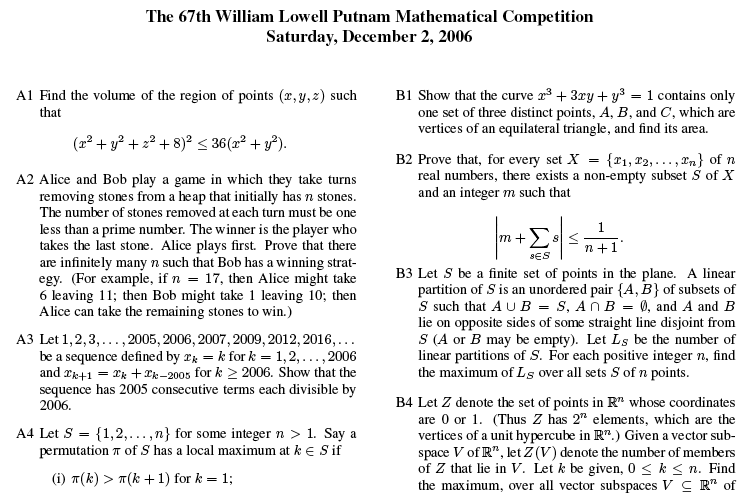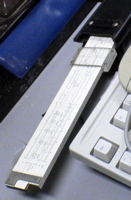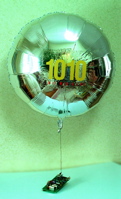Marvin Minsky
 Last night, I went to see Marvin Minsky talk in the Media Lab auditorium, specifically about his contributions to Stanley Kubrick‘s 2001: A Space Odyssey, on his new book (The Emotion Machine), and all sorts of other things.
Last night, I went to see Marvin Minsky talk in the Media Lab auditorium, specifically about his contributions to Stanley Kubrick‘s 2001: A Space Odyssey, on his new book (The Emotion Machine), and all sorts of other things.
Highlights from the talk (with minimal paraphrasing, hopefully):
- “I’ll give a better talk if the computer breaks, because I have an outline here… and… It’s very hard to follow an outline if you get a new idea.”
- “I like to make lists of disasters.”
- “[Kubrick] tried to get me to play chess but I wouldn’t.”
- [on NASA] “… and now they’re thinking of sending people to Mars which is crazy because they’ll be DEAD.”
- Minsky referring to his laser pointer as “the death ray”
- “[The estimate came from] me thinking of the 20-30 ways to estimate the number [of simple statements a 10- or 15-year-old child knows], and then diddling it until they all came out the same.”
- “But you know that most people have 4 or 5 emotions, like hunger and fear, and uh… whatever.”
- Marvin Minsky loves LISP.
- He uses a Mac and did his presentation by scrolling through many pages of a PDF.
- In response to this question: “If AI becomes as good as you’re describing… how should we treat these new machines ethically? Should we treat them like humans?”
Minsky: “If it was as smart as a person, it would very soon become much smarter, so you could ask it!”
If you’re interested in the movie stuff in particular, here’s a pretty good interview with Marvin Minsky, on working briefly with Kubrick.
If you want to get an idea of how Minsky talks about his ideas, here’s a nice transcript of a presentation Minsky made at the Game Developers Conference in 2001.
In school when they teach you about thinking or learning…and what’s school for? It’s not to learn about Inuit culture or Egyptian culture or algebra or geography or whatever? What you’re really in school for is to learn about thinking and learning.
Here is Marvin Minsky’s Wikipedia entry, notable to me at this moment because it has an active notation by Marvin himself in the “Trivia” section.
Neuron stains
I just got back from a neat lab for my hearing class, in which we got a tour of how to create 3-D models of neurons, see tonotopy in the cortex (with Fos labeling of cells stimulated at particular frequencies), and different types of stains of neurons in the cochlear nucleus.
Joe C. Adams showed us slides demonstrating the various neuron stains in a teaching microscope that had four extra eyepieces connected to it so that all five of us could look at the slides at the same time.
These pictures don’t do the staining justice. The Protargol (reduced silver) stains, which highlight nerve fibers, were so pretty that I wanted to make big prints of them and hang them on my wall. And I was hoping Google would help me find some really beautiful images of these things, but, alas.
I also got a kick out of seeing cartwheel cells, which look like cell bodies with arms coming out in all directions, and when you zoom in and out of the slide, you see new arms coming in and out of focus, making the whole cell look as though it’s spinning. Very cute!
Absolute pitch
Today I had my first known encounter with someone with perfect pitch. We were in my HST class (“Neural Coding and Perception of Sound”), and Bertrand was telling us about an experiment in which the signal was a sine wave “at 200 Hz… No, 220 Hz…” He was playing us the sound on speakers connected to his laptop: beeeeep. “200 or 220, I don’t remember. Anyone with absolute pitch here?”
And the student two seats over raised his hand half-sheepishly, and said, “It’s 220. A little less than 220 actually, but, yeah, 220.”
!!!!
(220 Hz is an A, and 196 Hz is the G right below it.)
!!!!
The Putnam (with numbers!)

When I was in high school, I went to math camp. And, of the math camp people, only the super-hardcore kids considered taking the Putnam exam. Hopefully this gives you an idea of what kind of exam it is. It’s a twelve hour test (two sittings) for college students (although high schoolers can take it), of “self-contained questions involving elementary concepts from group theory, set theory, graph theory, lattice theory, number theory, and cardinal arithmetic” ((http://math.scu.edu/putnam/describtcJan.html)). If you score in the top five in any year, you become a “Putnam Fellow“. MIT student Richard P. Feynman became a fellow in 1939 ((http://en.wikipedia.org/wiki/Putnam_exam)).
I don’t think about the Putnam much (really!). But today I read this article in The Tech (the MIT newspaper), and felt a wee bit of nerd pride:
MIT Sweeps Putnam, Team Takes Third Place
Half of the 26 monetary prize winners and 26 of the top 78 highest scoring participants… were MIT students this year, Rogers said. “We dominated the competition in a way that we never have before,†Rogers said. A total of 129 MIT students took the test this year… Of the top 200 scorers, according to Rogers, 49 were from MIT and 28 from Harvard.
The median score for this year’s competitors was zero out of a possible 120 points… MIT’s median was around 20 points out of the possible 120.
If you’re curious what the problems look like, previous tests (and solutions) can be found here.
How research gets done
This morning I had a lab for my class in hearing and perception of sound, at the Research Laboratory of Electronics on the MIT campus. We were doing a lab on “perceptual audio encoding”, which required us to take measurements in soundproof chambers. The place seriously looks like it hasn’t been changed since the 60s. Just when I was thinking, “Hey, this place couldn’t be more outdated even if it had a slide rule!”, I found a slide rule. Here is that slide rule:
And here are some other great futuristic items from the 60s!
LaTeX
“Lay-tex”, “Lay-tek”, “Lah-tek”, … I dunno, for some reason I thought LaTeX and LaTec (I think I made this one up) were pretty much the same thing. Like maybe LaTec was the open source version of LaTeX, or something. I mentioned this to Brent the other day (he’s writing his thesis in LaTeX), and we looked it up, to settle it once and for all! And here is what the always-correct Wikipedia says (now):
LaTeX is usually pronounced [ˈleɪ.tÉ›k] or [ˈlÉ‘.tÉ›k] in English (that is, not with the [ks] pronunciation English speakers normally associate with X, but with a [k]). The last character in the name comes from a capital χ (chi), as the name of TeX derives from the Greek Ï„Îχνη (skill, art, technique); for this reason, TeX’s creator Donald Knuth promotes a /tÉ›x/ pronunciation (that is, with a voiceless velar fricative as in Modern Greek, or the last sound of Scottish “loch” or German “Bach” or Arabic “Ø®”). Lamport, on the other hand, has said he does not favor or discourage any pronunciation for LaTeX.
So they are one and the same! My mind can be at ease once more.
Wheatstone bridge
W-H-E-A-T-S-T-O-N-E… bridge!! Wheatstone bridge.
Simple, and very useful!
Talking Mylar balloons
The topic today in sensors class was piezoelectric sensors. Joe P showed us a wonderful application for them: as both a microphone and speaker in a Mylar balloon.
The Responsive Environments Group has a page on the project:
Interactive Balloons
There is a great video on that page: Joe talking to a balloon, and then two balloons talking to each other.
Using an oscilloscope
By far the best thing I learned today was from watching Mark Feldmeier show me how to get my scope to do what I want. I’ve been twiddling knobs on these things for months now, and for some reason only just learned how to get the scope to:
- measure the frequency of a signal
- measure the voltage (peak-to-peak or avg or rms) of a signal
- limit high-frequency noise on a signal
I had always thought that turning the dials on the scope just changed the display parameters, but Mark told me that it actually affects the accuracy of the readings, since you are indeed adjusting gains inside the scope itself! The lesson: If you want to measure values from your signal, make the signal as big as you can on the screen.
I also learned what a Butterworth response is, yeehaw!
Writing a paper (Also: YouTube)
Soooo, today I remembered (re-learned) how to write a paper. Like this: read, take notes, note repetitive themes, write outline, flesh it out, write paper, done! *flop*
For distractions, a little YouTube dilly-dallying/lolligagging…
Take your pick!
Bunnies: http://www.youtube.com/watch?v=RXSaYJKnbeI
Jumping: http://www.youtube.com/watch?v=7vL19q8yL54&NR
Midgets and/or camels: http://www.youtube.com/watch?v=aJuaZKBABO0
Pool and dominos: http://www.youtube.com/watch?v=7GA3ySz4el4&NR








